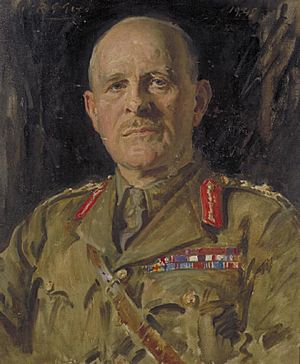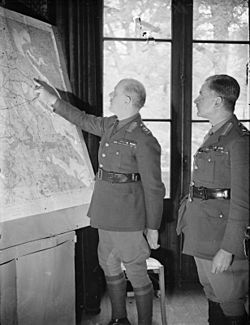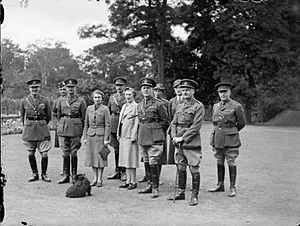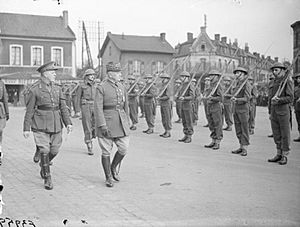John Vereker, 6th Viscount Gort facts for kids
Quick facts for kids
The Viscount Gort
|
|
|---|---|

Portrait of The Viscount Gort, by Reginald Grenville Eves
|
|
| High Commissioner for Palestine and Transjordan | |
| In office 1 November 1944 – 5 November 1945 |
|
| Monarch | George VI |
| Preceded by | Sir Harold MacMichael |
| Succeeded by | Sir Alan Cunningham |
| Governor of Malta | |
| In office 7 May 1942 – 26 September 1944 |
|
| Monarch | George VI |
| Preceded by | William Dobbie |
| Succeeded by | Edmond Schreiber |
| Governor of Gibraltar | |
| In office 14 May 1941 – 31 May 1942 |
|
| Monarch | George VI |
| Preceded by | Clive Gerard Liddell |
| Succeeded by | Noel Mason-Macfarlane |
| Personal details | |
| Born |
John Standish Surtees Prendergast Vereker
10 July 1886 Westminster, London, England |
| Died | 31 March 1946 (aged 59) Southwark, London, England |
| Spouse |
Corinna Vereker
(m. 1911; div. 1925) |
| Children | 3 |
| Parents | John Vereker, 5th Viscount Gort Eleanor Surtees |
| Relatives | William Philip Sidney, 1st Viscount De L'Isle (son-in-law) |
| Nickname | "Tiger" |
| Military service | |
| Allegiance | United Kingdom |
| Branch/service | British Army |
| Years of service | 1905–1945 |
| Rank | Field Marshal |
| Commands | British Expeditionary Force Chief of the Imperial General Staff Staff College, Camberley Guards Brigade 1st Battalion, Grenadier Guards 4th Battalion, Grenadier Guards |
| Battles/wars | First World War Second World War |
| Awards | Victoria Cross Knight Grand Cross of the Order of the Bath Commander of the Order of the British Empire Distinguished Service Order & Two Bars Member of the Royal Victorian Order Military Cross Mentioned in Despatches (9) |
Field Marshal John Standish Surtees Prendergast Vereker, 6th Viscount Gort (10 July 1886 – 31 March 1946) was a very important British Army officer. He was known for his bravery and leadership. During the First World War, he earned the Victoria Cross, which is the highest award for courage in battle. Later, he became the professional head of the British Army. He is most famous for leading the British Expeditionary Force (BEF) in France during the early part of the Second World War, especially during the Dunkirk evacuation. After this, Gort served as Governor of Gibraltar, Malta, and High Commissioner for Palestine and Transjordan.
Contents
Early Life
John Vereker was born in London, England. His mother was Eleanor, Viscountess Gort, and his father was John Gage Prendergast Vereker, the 5th Viscount Gort. He grew up in County Durham and the Isle of Wight.
He attended Harrow School and then the Royal Military College, Sandhurst, which is a famous military academy. In 1905, he became a second lieutenant in the Grenadier Guards, a well-known British Army regiment.
In 1908, an accident happened during a hunting trip in Canada, which sadly resulted in the death of a local guide. Gort returned to England soon after. He later studied at Trinity College, Cambridge. In 1910, he was chosen to lead the Grenadier Guards detachment that carried the coffin at the funeral of King Edward VII. For this service, he was made a Member of the Royal Victorian Order.
In 1911, Gort married Corinna Katherine Vereker. They had two sons and a daughter before they separated in 1925. His daughter, Jacqueline, later married William Sidney, who also became a Viscount.
A Hero in World War I
When the First World War began in August 1914, Gort was promoted to captain. He went to France with the British Expeditionary Force and fought on the Western Front. He took part in the difficult retreat from Mons.
He quickly rose through the ranks, becoming a staff officer and then a Brigade Major. He received the Military Cross in 1915 for his actions. He fought in major battles like the Battle of the Somme and the Battle of Passchendaele. For his bravery, he was awarded the Distinguished Service Order (DSO) and later a bar to his DSO.
On 27 November 1918, just after the war ended, Gort was awarded the Victoria Cross. This is the highest award for bravery in the face of the enemy for British and Commonwealth forces. He earned it for his actions on 27 September 1918 during the Battle of the Canal du Nord in France. Because of his courage, he became known as "Tiger" Gort. He was also mentioned in official reports for his good service eight times during the war.
Between the Wars
After World War I, Gort continued his military career. He attended the Staff College, Camberley, a school for senior army officers, and later became an instructor there. He was promoted to colonel in 1926.
He commanded the Brigade of Guards for two years starting in 1930. He also spent time in India overseeing military training. In 1932, he learned to fly an airplane. By 1935, at the age of 49, he was promoted to major-general. In 1936, he returned to the Staff College as its Commandant, which means he was in charge of the school.
In 1937, Gort became the Military Secretary to the War Minister, Leslie Hore-Belisha. Soon after, he was appointed Chief of the Imperial General Staff (CIGS). This made him the professional head of the British Army. He was also made a Knight Commander of the Order of the Bath. As CIGS, Gort believed it was most important to build a strong land army to defend France and the Low Countries against a possible German attack.
World War II and Dunkirk
When the Second World War began in September 1939, Prime Minister Neville Chamberlain chose Gort to be the Commander-in-Chief of the British Expeditionary Force (BEF) in France.
In May 1940, the German army launched a surprise attack through the Ardennes forest. This attack split the Allied armies and surrounded the French First Army and the BEF. Gort made a very important decision. He decided to ignore orders from the British government to attack south. Instead, on 25 May 1940, he ordered the BEF to retreat northwards towards the French coast.

This decision led to the famous Dunkirk evacuation, where a huge number of British and Allied soldiers were rescued from the beaches of Dunkirk and brought back to Britain. While France was defeated and surrendered to Germany soon after, Gort's decision is seen by some historians as crucial in saving the BEF. Others have a more critical view of his leadership during this difficult time.
After returning to England, Gort was given non-combat roles. The new Prime Minister, Winston Churchill, felt Gort was not suited for leading troops in battle after the chaotic retreat from France.
Later Roles and Legacy
Gort served as Governor of Gibraltar from 1941 to 1942. In 1943, he became the Colonel Commandant of the Honourable Artillery Company.
He then became Governor of Malta from 1942 to 1944. During the difficult siege of Malta by Axis forces, Gort showed great courage and leadership. The people of Malta gave him a Sword of Honour to recognize his bravery. He also pushed for extending the airfield on the island, which proved very important for the British during the Battle of the Mediterranean. In June 1943, King George VI personally presented Gort with his field marshal's baton in Malta. Gort was also present when the Italian surrender was signed in Valletta harbour in September 1943.
Gort's final role was as High Commissioner for Palestine and Transjordan. He served there for about a year. During his time, he tried to build good relationships with both Jewish and Arab communities, and he was respected by both. However, tensions were growing in Palestine. Gort's health began to decline during this period. He stepped down from his role in November 1945 and returned to Britain.
Death
After returning to England, Gort was admitted to Guy's Hospital in London. Doctors discovered he was suffering from a serious illness. In February 1946, he was given a new title, becoming a Viscount in the Peerage of the United Kingdom. On 31 March 1946, he passed away at the age of 59. Since he had no surviving son, his Irish Viscountcy title passed to his brother, Standish Vereker. He was buried in the Sidney family vault at St. John the Baptist Church in Kent.
In Film
Gort was played by actor Cyril Raymond in the 1958 film Dunkirk.



